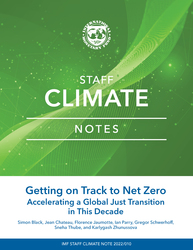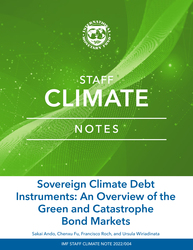
Sleepwalking to the Cliff Edge? A Wake-up Call for Global Climate Action
Urgent action to cut greenhouse gas (GHG) emissions is needed now. Further delay will lead to an ‘emissions cliff edge’, implying implausible cuts in GHGs and putting put 1.5°C beyond reach. This Note provides IMF staff’s annual assessment of global climate mitigation policy.
READ MORE...
Volume/Issue:
Volume 2024
Issue 006
Publication date: October 2024
ISBN: 9798400289644
$5.00
Add to Cart by clicking price of the language and format you'd like to purchase
Available Languages and Formats
| English |
Prices in red indicate formats that are not yet available but are forthcoming.
Topics covered in this book
This title contains information about the following subjects.
Click on a subject if you would like to see other titles with the same subjects.
Economics- Macroeconomics , Taxation - General , Environmental Economics , Environmental Conservation and Protection , Public Policy- Environmental Policy , Indonesia , Climate change , Fuel prices , Climate finance , Greenhouse gas emissions , Climate policy , Carbon tax , Africa , Global , Paris Agreement , climate mitigation , carbon pricing , climate finance , climate investment
Also of interest
Summary
Urgent action to cut greenhouse gas (GHG) emissions is needed now. Early next year, all countries will set new emissions targets for 2035 while revising their 2030 targets. Global GHGs must be cut by 25 and 50 percent below 2019 levels by 2030 to limit global warming to 2°C and 1.5°C respectively. But current targets would only cut emissions by 12 percent, meaning global ambition needs to be doubled to quadrupled. Further delay will lead to an ‘emissions cliff edge’, implying implausible cuts in GHGs and putting put 1.5°C beyond reach. This Note provides IMF staff’s annual assessment of global climate mitigation policy. It illustrates options for equitably aligning country targets with the Paris Agreement’s temperature goals. It also provides guidance on modelling needed to set emissions targets and quantify climate mitigation policy impacts.
Copyright © 2010 - 2026
Powered by:
AIDC



